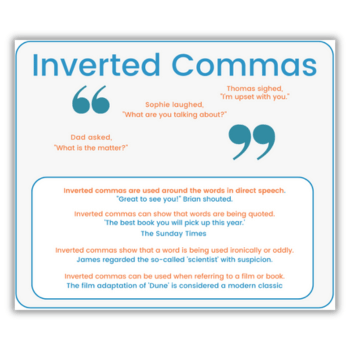KS2
Years 3-6
Inverted commas, also known as quotation marks or speech marks, are an essential part of the English curriculum. They are first introduced in KS2.
We use them to punctuate direct speech, enclose quotations or highlight certain words or phrases, such as titles or ironic text.
The national curriculum for English requires Year 3 pupils to learn how to use inverted commas to indicate speech in their writing. For example, they might punctuate a sentence like: Sarah said, “I can’t wait to go to the park!”
As pupils progress through KS2, their understanding deepens. They learn to punctuate more complex speech with additional punctuation, such as commas, question marks or exclamation marks.
Inverted commas poster
This inverted commas poster is a valuable teaching aid that visually demonstrates how to use inverted commas correctly.
It explains their primary purpose: enclosing direct speech, for example: Sophie laughed, “What are you talking about?”
The poster also highlights their use when quoting another person’s words, as in: ‘The best book you will pick up this year.’ – The Sunday Times
Additionally, it explains how they can signal irony or sarcasm, such as in: James regarded the so-called ‘scientist’ with suspicion.
The poster also shows an example of referring to the title of a book/film, such as: The film adaptation of ‘Dune’ is considered a modern classic.
What are inverted commas?
Inverted commas are punctuation marks that we use to set apart speech, quotations, titles or specific words or phrases.
They typically appear in pairs and can be single (‘ ’) or double (“ ”) depending on style or context. Teachers often emphasise consistent usage in pupils’ writing to improve clarity and correctness.
The Teaching Couple have over a decade of experience in the education sector and provide advice and resources for teachers.

Similar resources
- Shakespeare rap – Write, perform and master metre
- Stone Age to Iron Age – KS2 medium-term plan with resources
- Buddhism charity KS2 – Explore dāna (Buddist generosity concept)
- Solubility KS2 – Investigate solubility with common ingredients
- Fast fashion effects on environment – Fashion show art lesson













